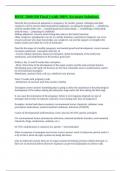BSNC 5000 OB Final || with 100% Accurate Solutions.
Describe the psychosocial adaptation to pregnancy for mother, partner, sibling(s) and other
caregivers correct answers Maternal/paternal adaptation: accepting the pregnancy → identifying
with the mother/father role → reordering personal relationships → establishing a relationship
with the fetus → preparing for childbirth
Sibling adaptation: concerns about losing their place in the family hierarchy
Other caregivers: grandparents can act as a family historian, experienced caregivers can act as
resource persons who share knowledge, any caregivers can provide support to strengthen the
family system and widen the circle of nurturance
Describe the stages of a healthy pregnancy and normal growth and development. correct answers
Ovum/pre-embryonic: conception until day 14
- Covers cellular replication, blastocyst formation, initial development of the embryonic
membranes, and establishment of the primary germ layer
Embryo: day 15 until 8 weeks after conception
- Most critical time in the development of the organ systems and the main external features.
Developing areas with rapid cell division are the most vulnerable areas to malformation caused
by environmental teratogens
Membranes, amniotic fluid, yolk sac, umbilical cord, placenta
Fetus: 9 weeks until pregnancy ends
- Refinement of structure until fetus reaches viability
Teratogens correct answers Something that is going to affect the anatomical or the physiological
development of the embryo during the embryonic stage and/or the fetus during the fetal stage
It can cause the termination of the pregnancy before it even happens (depends on type of
teratogen and severity of exposure, typically occurs during early days of pregnancy)
Examples: alcohol and tobacco products; environmental toxins, chemicals, radiation; some
prescription medications; maternal medical conditions; infections (TORCH)
Causes of developmental malformations correct answers 20-25%: genetic anomalies
5%: environmental factors (intrauterine infections, maternal metabolic disorders, environmental
chemicals, drugs, medications, radiation, etc.)
65-75%: multifactorial or unknown (ex. genetic + environmental)
When is exposure to teratogens most severe correct answers week 5 (embryonic period, weeks 3
to 8) as this is when all organ systems are being laid down
prior to embryonic period, there are no organ systems developing yet (just cellular division), so
there are no structural defects (however exposure can prevent implantation to uterine wall)
,List TORCH infections correct answers Toxoplasmosis
Other symptoms such as syphilis, parvovirus, and Hep B
Rubella
Cytomegalovirus (CMV)
Herpes simplex virus (HSV)
Modes of transmission of TORCH infections correct answers VERTICAL TRANSMISSION
(mother to baby in utero):
- transplacental transmission (maternal circulation --> placenta --> fetal blood supply) (all except
Hep B)
- contact with cervical or vaginal secretion during birthing process (syphilis, CMV, HSV, Hep B)
- By breastmilk in premature and IUGR infants (CMV)
- During c-section where child is exposed to blood
Toxoplasmosis correct answers a parasite acquired through undercooked meat or spores from cat
litter
treatment helps prevent passage through placenta, reducing rate of infection by up to 60%
Often causes hearing loss
Syphilis correct answers bacterium
can cause hydrops fetalis
if mom is not treated: still birth 25%, neonatal death 14%, congenital syphilis 41%
if syphilis during pregnancy is untreated, 70-100% of neonates born will have symptomatic
congenital syphilis (hydropic and anemia with enlarged liver and spleen), with fetal demise
occuring in 40% of these pregnancies
Parvovirus B19 correct answers Virus
vertical transmission rate of 25-50%
Can cause hydrops fetalis, 13% spontaneous loss before 20 weeks gestation
transplacental transmission is approximately 30% and fetal death occurs in about 9% of those
affected
, Hepatitis B correct answers Virus
Too large to cross placenta, infection occurs via microtransfusion during labour, SVD or C-
section (contact with infectious secretions), 70-90% of time
Often no congenital effects on fetus... if fetus is exposed, shots are given to prevent infection
Rubella correct answers Virus
unvaccinated mother/mother with low antibody titre
first trimester infections cause congenital rubella syndrome in up to 85% of neonates (heart
defects, hearing loss, cataracts, developmental delays) --> non reversable
the risk for congenital abnormalities varies with the fetus's gestational age at the time maternal
infection occurs, ranging from diabetes mellitus, hearing loss, miscarriage, or stillbirth
At what rubella titer # would the postpartum client receive an MMR or MMRV vaccine? correct
answers Anything less than 10
Cytomegalovirus correct answers Virus
Transplacental, SVD, breast milk
Leading cause of non-genetic congenital hearing loss, can also cause defects to CNS, GI, heart,
placenta
can result in miscarriage, stillbirth, or congenital illness, yet most infected infants are
asymptomatic at birth and develop symptoms after the first year of life (hearing loss,
microcephaly, cognitive impairment, neuromuscular deficits, tooth enamel defect, chorioretinitis)
Herpes Simplex Virus correct answers Virus
Vertical transmission during SVD when mother has active infection/sores
3 categories of infection:
- skin, eyes, mouth (therapy 100% treats, no therapy 62% resolve)
- meningitis (therapy treats 31%, no therapy has high mortality rate)
- disseminated (therapy 83% normal outcome, no therapy has high mortality rate)
HIV correct answers infants born to seropositive mothers should be presumed to be HIV positive
until proven otherwise. Management begins by implementing routine practices. Measures should
also be taken to protect the infant from further exposure to maternal blood and body fluids
Varicella zoster correct answers when infection occurs in the last few days of pregnancy or the
first postpartum days, up to 30% of infants will develop clinical varicella




